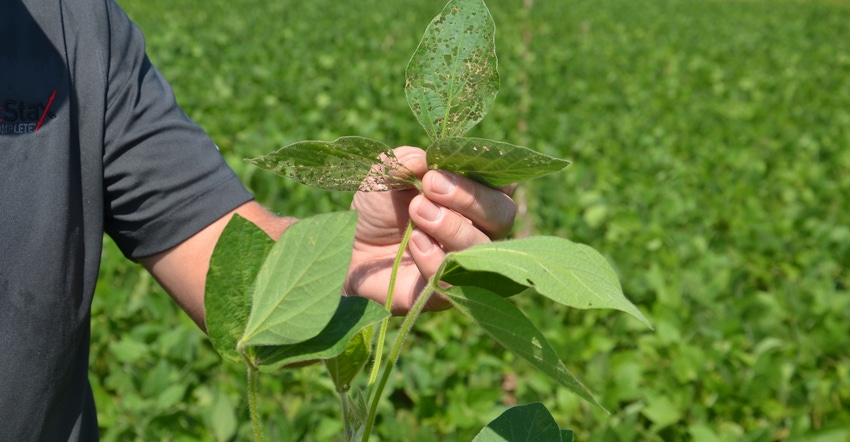
The upper leaves of soybeans looked rather ragged in certain areas when Steve Gauck visited the Soybean Watch ’18 field recently. He determined that the tattered appearance was due to feeding by Japanese beetles.
Soybeans are relatively high on the beetles’ preferred feeding list, although give them a grapevine and they will target it first every time. Still, Japanese beetles emerged early in 2018, and started chewing on soybean leaves in some fields in late June.
“They tend to feed on top leaves, and the damage can look worse than it is,” Gauck says. He’s a Beck’s sales agronomist based near Greensburg, Ind. Beck’s sponsors Soybean Watch ’18.
Gauck points out two main lessons for scouting.
Judge individual leaf loss
The first lesson boils down to the fact that damage on a single leaf may look worse than it is, Gauck says. He carries the Purdue University Corn & Soybean Field Guide in his back pocket when he walks fields. The guide contains a chart showing actual leaf loss percentages for various patterns of leaf loss. He compares individual leaves to the chart to determine the amount of leaf loss that may have occurred.
On top leaves that have been attacked by Japanese beetles, it’s not uncommon to find 50% loss, Gauck says. However, on leaves farther down in the canopy, loss is likely to be much less intense. He typically finds leaves lower in the canopy may only have 5% to 15% loss — if they are damaged at all. See Page 131 of the 2018 edition of the pocket guide to find the defoliation comparison chart.
 HOW MUCH DAMAGE? It’s easy to overestimate damage even on a single leaf, Steve Gauck says. Here he compares one leaf to the Purdue guide chart. He estimates loss on this leaf at less than 50%.
HOW MUCH DAMAGE? It’s easy to overestimate damage even on a single leaf, Steve Gauck says. Here he compares one leaf to the Purdue guide chart. He estimates loss on this leaf at less than 50%.

Judge whole plant leaf loss
The second lesson is that since insects, particularly Japanese beetles, tend to feed more heavily on upper leaves, your eye may play tricks on you when you attempt to estimate total percent leaf loss for an entire plant.
Often, the percentage is much lower than you first think when you look at a plant. That’s partly because your eyes are drawn to damage on top leaves, giving the plant an unsightly appearance. But when you factor in numerous leaves that typically have little or no damage lower on the plant, it takes a large amount of damage in the upper part of the plant to move the needle toward the threshold for treatment. The threshold is the allowable percentage of leaf loss before yield will be impacted.
That threshold isn’t constant over the entire season, Gauck notes. Earlier in the season, plants can withstand more damage without experiencing permanent injury and resulting yield loss than later in the season. Once plants are in the reproductive stage, the threshold drops. It remains lower until the seed matures later in the season.
For example, for Japanese beetles, the Purdue guide recommends treatment if 15% of total leaf tissue is lost during blooming to pod fill, or stages R1 through R5. Before blooming, plants can lose 40% of total leaf tissue before treatment would be justified. After full seed is produced at stage R6, the threshold that triggers treatment increases again to 25%.
About the Author(s)
You May Also Like




